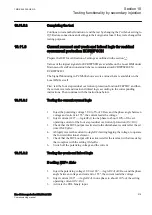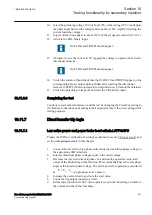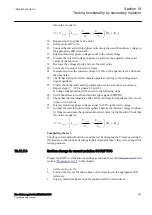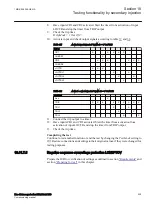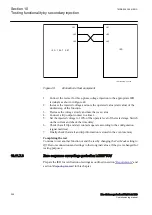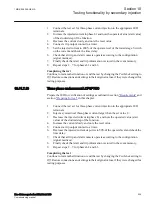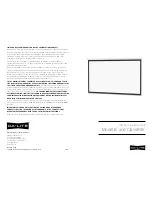
occur for each separate fault and only corresponding two trip outputs (TRLn)
should be activated at a time. Functional outputs TRIP and TR2P should be
active at each fault. No other outputs should be active.
4.
Initiate a three-phase fault.
Take an adequate time interval between faults into consideration, to overcome a
reclaim time, which may be activated by SMBRREC. Only a three-phase trip
should occur for the fault and all trip outputs (TRLn) should be activated at the
same time. Functional outputs TRIP and TR3P should be active at each fault. No
other outputs should be active.
5.
Initiate a single phase-to-earth fault and switch it off immediately when the trip
signal is issued for the corresponding phase. Initiate the same fault once again
within the reclaim time of the used SMBRREC.
A single-phase fault shall be given at the first fault. A three-phase trip must be
initiated for the second fault. Check that the corresponding trip signals appear
after both faults. Functional outputs TRIP, TRLn and TR1P should be active
during first fault. No other outputs should be active. Functional outputs TRIP, all
TRLn and TR3P should be active during second fault.
6.
Initiate a single phase-to-earth fault and switch it off immediately when the trip
signal is generated for the corresponding phase. Initiate the second single-phase-
to-earth fault in one of the remaining phases within the time interval, shorter than
tEvolvingFault
(default setting 2.0s) and shorter than the dead-time of
SMBRREC, when included in the protection scheme.
Check that the second trip is a three-phase trip and that a three-phase
autoreclosing attempt is given after the three-phase dead time. Functional
outputs TRIP, TRLn and TR1P should be active during first fault. No other
outputs should be active. Functional outputs TRIP, all TRLn and TR3P should
be active during second fault.
7.
Initiate a phase-to-phase fault and switch it off immediately when the trip signal
is issued for the corresponding two phases. Initiate a second phase-to-phase fault
between two other phases within the time interval, shorter than
tEvolvingFault
(default setting 2.0s).
Check, that the output signals, issued for the first fault, correspond to a two- trip
for included phases. The output signals generated by the second fault must
correspond to the three-phase tripping action.
10.12.1.4
Circuit breaker lockout
The following tests should be carried out when the built-in lockout function is used in
addition to possible other tests, which depends on the complete configuration of an
IED.
1.
Check that
AutoLock
and
TripLockout
are both set to
Off
.
2.
Activate shortly the set lockout (SETLKOUT) signal in the IED.
3.
Check that the circuit breaker lockout (CLLKOUT) signal is set.
4.
Activate shortly thereafter, the reset lockout (RSTLKOUT) signal in the IED.
5.
Check that the circuit breaker lockout (CLLKOUT) signal is reset.
6.
Initiate a three-phase fault.
Section 10
1MRK 506 355-UEN A
Testing functionality by secondary injection
232
Line distance protection REL670 2.1 IEC
Commissioning manual
Summary of Contents for Relion 670 Series REL670
Page 1: ...Relion 670 series Line distance protection REL670 2 1 IEC Commissioning manual ...
Page 2: ......
Page 30: ...24 ...
Page 34: ...28 ...
Page 64: ...58 ...
Page 68: ...62 ...
Page 90: ...84 ...
Page 254: ...248 ...
Page 260: ...254 ...
Page 269: ...263 ...


